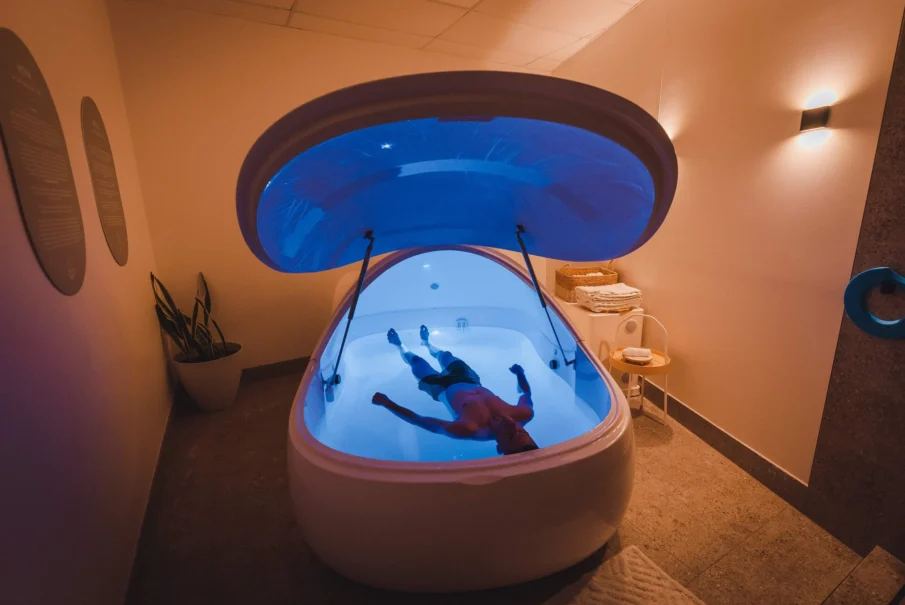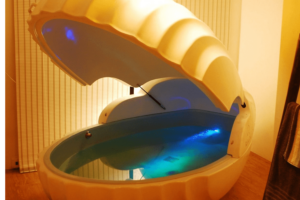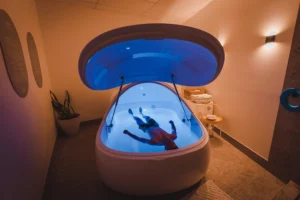Sleep is no longer a luxury, it’s a necessity. With more people struggling to get restful sleep, innovative therapies like Float Session Therapy are gaining attention for their potential to combat insomnia and other sleep-related disorders. But why does Float Session Therapy work so well for insomnia and sleep issues? Let’s explore the science behind float therapy, the benefits of floatation tanks, and why sensory deprivation float therapy is a game-changer in the world of wellness.
What Is Float Session Therapy?
Float Session Therapy, also known as Isolation Tank Therapy or Sensory Deprivation Float Therapy, involves floating in a tank filled with warm water and Epsom salt. The purpose of a sensory deprivation tank is to eliminate external stimuli light, sound, gravity so your body and mind can deeply relax. This is where the effects of float therapy start to work their magic.
By removing sensory input, the brain enters a state similar to meditation or REM sleep, which promotes deep healing. Many people turn to Float Therapy for relaxation, but its potential to improve sleep goes far beyond just stress relief.
Why Does Float Session Therapy Help With Sleep and Insomnia?
1. Promotes Deep Relaxation
When you’re lying in a float tank, your muscles aren’t working to support your body. This weightlessness, combined with silence and darkness, triggers a deep relaxation response, lowering cortisol (stress hormone) levels. As a result, your nervous system calms down paving the way for restful sleep.
2. Improves Sleep Hormone Balance
Studies show that float therapy for depression and anxiety often leads to better regulation of serotonin and melatonin, the hormones responsible for mood and sleep. One of the major float therapy session benefits is this hormonal balance, which is critical for people with insomnia.
3. Reduces Anxiety and Racing Thoughts
For many, insomnia is linked to anxiety or a restless mind. The float tank anxiety benefits come into play here. The meditative state achieved in a float session allows the mind to slow down and release tension. Regular sessions can reduce generalized anxiety, which is often a root cause of poor sleep.
Health Benefits of Float Therapy Related to Sleep
Let’s break down the health benefits of float therapy that directly or indirectly improve sleep:
- Stress Reduction: The anti-stress effect of sensory deprivation float therapy is well-documented. Less stress = better sleep.
- Pain Relief: Chronic pain sufferers often struggle with sleep. Float tank therapy benefits include muscle relaxation and pain reduction.
- Mood Enhancement: A calm mind sleeps better. The benefits of float therapy include a mood boost thanks to increased dopamine production.
- Sleep Cycle Regulation: Users often report normalized circadian rhythms after multiple float therapy sessions.
- Improved Focus During the Day: Better sleep at night leads to increased alertness and productivity, creating a positive cycle.
Scientific Backing: The Science Behind Float Therapy
The science behind float therapy is supported by growing research. Floatation has been shown to activate the parasympathetic nervous system, which promotes calm, digestion, and rest.
Brainwave studies indicate that time in a floatation tank mimics the theta brainwave state—a phase between wakefulness and sleep. People often fall asleep during a session and wake up feeling fully rested, further proving the effects of float therapy on sleep.
One study from the Journal of Complementary and Behavioral Medicine found that just one float therapy session significantly reduced cortisol and improved sleep quality.
What Are the Benefits of Sensory Deprivation Float Tanks?
The benefits of sensory deprivation float tanks go beyond sleep improvement. Here are a few:
- Enhanced creativity and focus
- Lower blood pressure
- Detoxification through Epsom salts
- Deeper meditative state
- Faster muscle recovery for athletes
- Reduction in depression and anxiety symptoms
For those wondering “Float Therapy, what is it?”This list demonstrates that it’s more than just floating, it’s holistic healing.
Real-Life Case Studies
Many users struggling with long-term insomnia have turned to Float Session Therapy after trying everything from medication to meditation. They often report better sleep after just 2–3 sessions and lasting improvement with regular use.
Athletes and high-stress professionals in particular report improvements not only in sleep quality but in focus and daytime energy thanks to the benefits of floatation tanks.
Float Therapy for Depression and Sleep
Insomnia and depression often go hand-in-hand. The float therapy for depression approach has shown great promise, especially when combined with traditional treatments.
The benefits of float therapy include a better mental outlook, which can indirectly ease insomnia symptoms. Plus, the isolation tank therapy experience helps individuals detach from overwhelming thoughts, leading to better sleep onset and continuity.
Benefits of Float Session Therapy Over Traditional Sleep Treatments
While medication can help, many sleep aids have side effects and dependency risks. In contrast, float session therapy offers a natural, side-effect-free solution that enhances your body’s innate healing processes.
If you’ve tried meditation, therapy, or sleep hygiene routines without success, consider the float deprivation tank benefits as a complementary approach to your sleep toolkit.
FAQs: Float Session Therapy for Sleep Issues
What is float session therapy, and how does it help with sleep?
Float Session Therapy involves floating in a saltwater tank that removes external stimuli. It helps with sleep by reducing stress, anxiety, and overactive brain activity—all common causes of insomnia.
How many sessions of float therapy are needed to see results?
Many people report better sleep after just one session, but consistent weekly sessions provide lasting results. The benefits of float therapy are cumulative.
Can float therapy cure insomnia?
While not a “cure,” float therapy significantly reduces the severity and frequency of insomnia symptoms by addressing the root causes like stress, anxiety, and hormonal imbalance.
Are there any side effects of float session therapy?
Float therapy is generally safe for most people. Some may experience lightheadedness or slight nausea after the first session, but these effects usually disappear quickly.
What makes float tank therapy different from other relaxation techniques?
Unlike surface-level techniques, float tank therapy benefits come from a complete shutdown of external stimuli, allowing the nervous system to enter a true healing state.
Is float therapy suitable for everyone?
Yes. However, individuals with certain medical conditions should consult a doctor before starting sensory deprivation float therapy.
Does float therapy help with other mental health issues besides sleep?
Absolutely. It’s proven helpful for anxiety, depression, PTSD, and even chronic pain—making it a holistic treatment with multiple benefits.
Conclusion
So, why does Float Session Therapy work so well for insomnia and sleep issues? Because it directly targets the root causes: stress, overthinking, physical tension, and disrupted sleep hormones. From the float tank anxiety relief to the profound health benefits of float therapy, this innovative approach is changing how people heal.
If you’re seeking a natural, effective, and deeply restorative method to finally get quality sleep, give Float Session Therapy a try. Your body and your brain will thank you.





